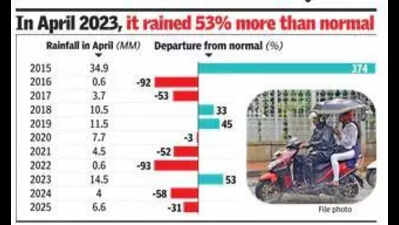- News
- City News
- gurgaon News
- Pre-monsoon blues: Gurgaon faces 65% rain deficit, Haryana 31%
Trending
Pre-monsoon blues: Gurgaon faces 65% rain deficit, Haryana 31%
Gurgaon: Haryana received just 6.6mm of rainfall in April, which is 31% below the normal average of 9.5mm for the month. This marks the second consecutive month with below-normal rainfall during the crucial pre-monsoon season, raising concerns about water availability across the state. Last year, rainfall in April was 4mm, while in 2023, it was 14.5mm. The city, this year, has received 2.7mm rainfall, 65% below the normal 7.7mm.
The current rainfall in the state shortfall fits into this pattern of erratic pre-monsoon precipitation, which poses ongoing challenges for the region. Given that approximately 60% of Haryana's groundwater resources are classified as over-exploited, the below-normal rainfall intensifies the strain on water availability, particularly for irrigation and drinking purposes.
You Can Also Check: Gurgaon AQI | Weather in Gurgaon | Bank Holidays in Gurgaon | Public Holidays in Gurgaon
In contrast, some districts such as Mahendragarh and Jind recorded above-normal rainfall, receiving 129% and 87% more precipitation than usual, respectively, highlighting a mixed pattern across Haryana. Historically, Haryana's April rainfall has shown considerable variability over the past 26 years. The highest recorded rainfall was in 2015, with 34.9mm, which was 374% above normal, while years like 2002 saw extreme drought conditions with just 1.1mm, representing an 84.7% deficit.
Research scientist Dr Manish Kumar, who leads the Adaptation & Risk Analysis group at Centre for Study of Science, Technology and Policy (CSTEP), said, "Pre-monsoon showers in North India are critical for groundwater replenishment, which is at its lowest during summer months and for the growth of horticultural crops such as mango and litchi." "While the current deficit could be part of short-term climate fluctuations, the projected long-term decline in rainfall in parts of Haryana is a matter of grave concern for farmers and citizens alike," CSTEP scientist Manish Kumar said.
The top five districts in Haryana with the highest rainfall deficits were Faridabad, Ambala, Kurukshetra, Jhajjar and Gurgaon, IMD data says. Faridabad experienced the most significant shortfall, receiving only 0.9mm of rainfall, which is 93% below the normal 11.6 mm. Ambala followed with 3.9mm, 74% below the normal 15.2mm. Kurukshetra recorded 2.7mm, 73% below the normal 9.9mm. Jhajjar saw 2.4mm of rainfall, 67% below the normal 7.2mm. Lastly, the city received 2.7mm, 65% below the normal 7.7 mm.
End of Article
Follow Us On Social Media










